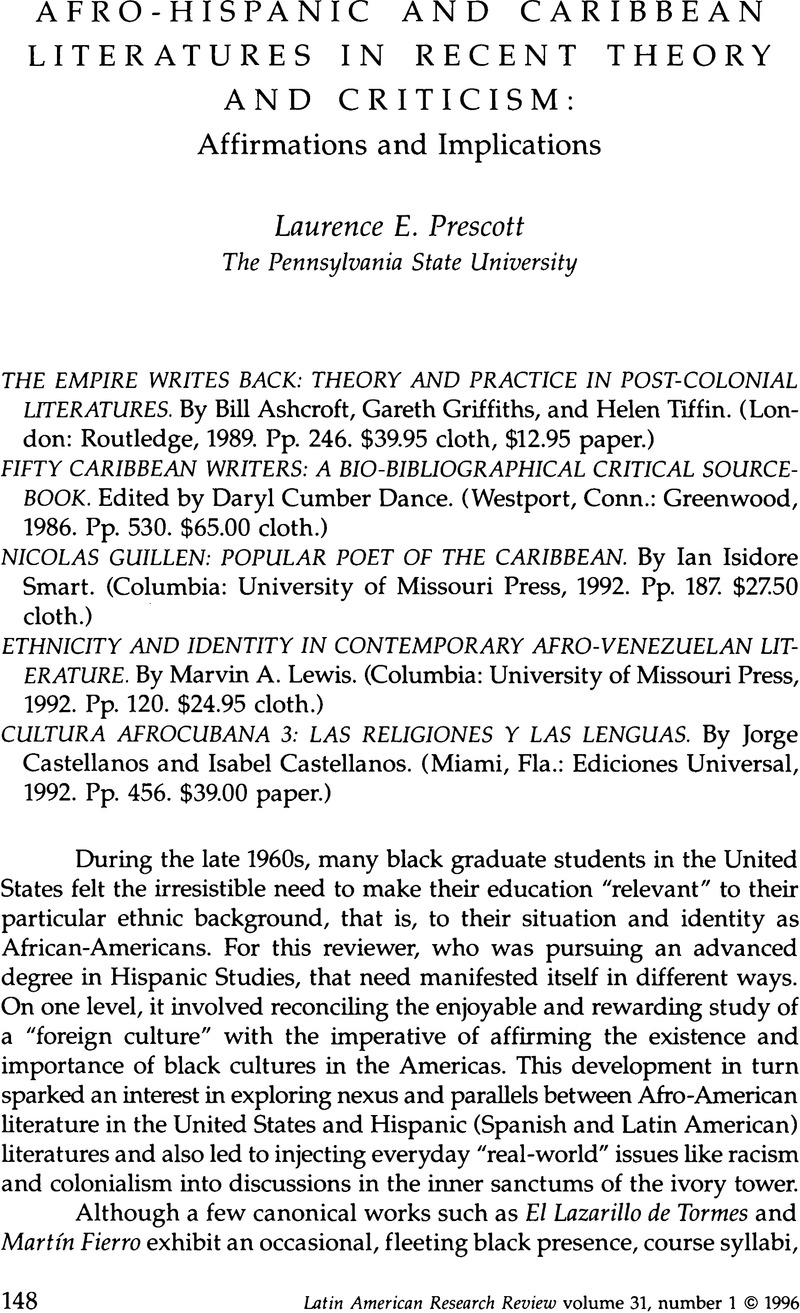No CrossRef data available.
Published online by Cambridge University Press: 05 October 2022

1. Edward Said, Culture and Imperialism (New York: Vintage-Random House, 1994), xiii.
2. The most notable of these journals, the Afro-Hispanic Review, was founded in Washington, D.C., in 1982 under the editorship of Stanley Cyrus and Ian Smart, two professors at Howard University. Since 1986 the journal has been edited at the University of Missouri-Columbia by Marvin Lewis and Edward Mullen. América Negra (Expedición Humana a la Zaga de la América Oculta) made its first semi-annual appearance in June 1991, published by the Pontificia Universidad Javeriana in Bogotá and edited by anthropologists Nina de Friedemann, Jaime Arocha Rodríguez, and Jaime Bernal Villegas. The latest periodical concerned with peoples of African descent in Latin America is the Journal of Afro-Latin American Studies and Literature, whose inaugural issue came out in 1993 in Washington, D.C.
3. It is noteworthy, for example, that Ashcroft, Griffiths, and Tiffin, relying on Tzvetan Todorov's The Conquest of America to illustrate the power and function of writing in the colonial situation, attribute Hernán Cortez's defeat of the Aztecs to his seizure and domination of the means of communication and production of discourse and symbols, made possible largely by use of an interpreter and the authority imposed by a system of writing. See The Empire Writes Back, 79–81.
4. Raimundo Lazo, La novela andina (Mexico City: Porrúa, 1971).
5. See Richard L. Jackson, Black Writers in Latin America (Albuquerque: University of New Mexico Press, 1979); and Marvin A. Lewis, Afro-Hispanic Poetry, 1940–1980: From Slavery to “Negritud” in South American Verse (Columbia: University of Missouri Press, 1983).
6. See, for example, Manuel Zapata Olivella, “Creación y autenticidad: América mestiza, un gran tema de novela,” El Tiempo, 10 Nov. 1963, Lecturas Dominicales section, p. 3; and Zapata Olivella, ¡Levántate, mulato! ‘Por mi raza hablará el espíritu‘ (Bogotá: Rei Andes, 1991).
7. For a lucid example of this situation, see Jaime Arocha Rodríguez, “Afro-Colombia Denied,” NACLA Report on the Americas, no. 25 (Feb. 1992):28–31. This issue devoted to The Black Americas also features articles on the Dominican Republic, Brazil, and Cuba. Other essays on this topic may be found in Contribución a la cultura de las Américas, a volume of papers and presentations from the September 1992 colloquium of the same name, edited by Astrid Ulloa (Bogotá: Instituto Colombiano de Antropología, 1993).
8. I am not suggesting, however, that the perspectives and ideas presented here are completely new. In the early 1970s, for example, George Kent questioned the matter of universalism in Blackness and the Adventure of Western Culture (Chicago, Ill.: Third World, 1972).
9. Vera M. Kutzinski, Against the American Grain (Baltimore, Md.: Johns Hopkins University Press, 1987).
10. See Jorge Artel, “Modalidades artísticas de la raza negra,” Muros 1 (June 1940):17 (published in Cartagena); Manuel Zapata Olivella, El hombre colombiano (Bogotá: Canal Ramírez-Antares, 1974); Zapata Olivella, Las claves mágicas de América (raza, clase, cultura) (Bogotá: Plaza y Janés, 1989); and his previously cited ¡Levántate, mulato! These writers' embrace of the indigenous element, however, is in no way analogous to that of many Dominican citizens who prefer to call themselves “indio” to avoid association with any African heritage, particularly as represented by neighboring Haiti. Nor is it similar to the custom of some racially mixed African-Americans of the United States, who out of disdain or fear rejected the designation “Negro”—and with it black identity and African roots—and gave primacy to their Native American ancestors by referring to themselves as “Indian.”
11. Rito Llerena Villalobos, Memoria cultural en el vallenato: un modelo de textualidad en la canción folclórica colombiana (Medellín: Centro de Investigaciones, Facultad de Ciencias Humanas, Universidad de Antioquia, 1985).
12. See, for example, Ciro Quiroz Otero, Vallenato: hombre y canto (Bogotá: Icaro, 1983). A recent publication specifying the European, Native American, and African origins of the three main instruments of vallenato music is Consuelo Araujonoguera, Lexicón del Valle de Upar (Santa Fe de Bogotá: Instituto Caro y Cuervo, 1994), 202.
13. Yvonne Captain-Hidalgo, “Writing for the Future: Afro-Hispanism in a Global, Critical Context,” Afro-Hispanic Review 13 (Spring 1994):3–9, citation on 5.
14. Compare Winthrop R. Wright, Café con leche: Race, Class, and National Image in Venezuela (Austin: University of Texas Press, 1990), 113. Wright describes Sojo as a “mulatto author.”
15. See José Marcial Ramos Guédez, El negro en la novela venezolana (Caracas: Dirección de Cultura, Universidad Central de Venezuela, 1980), 97–132.
16. The earlier volumes are Cultura afrocubana 1: El negro en Cuba, 1492–1844 (Miami, Fla.: Ediciones Universal, 1988); and Cultura afrocubana 2: El negro en Cuba, 1845–1959 (Miami, Fla.: Ediciones Universal, 1990).
17. See, for example, George Eaton Simpson, Black Religions in the New World (Irvington-on-Hudson, N.Y.: Columbia University Press, 1978).
18. Sojo's assertion also reminds us that although Latin Americanists may speak of Latin American literature as a whole, we must not forget that each country within this vast region is a separate entity with its own history and its own literary tradition. Consequently, even though countries like Cuba and Colombia were both conquered and colonized by the Spanish, imported enslaved Africans to perform the heavy labor that enriched their colonial coffers, now count sizable numbers of persons of African descent among their population, and have produced several outstanding writers and admirable works of literature, their literary traditions—especially the part related to people of African descent—differ in many respects. I demonstrate this point by contrasting briefly the Afro-Cuban literary heritage and the difficulties encountered by blacks writing in Colombia in “Perfil del autor afro-colombiano: problemas y perspectivas,” forthcoming in América Negra. My book manuscript on Colombian poet Jorge Artel and the struggle for black literary expression in Colombia also elaborates on this question.
19. For a study of this collection and information on Obeso, see Laurence E. Prescott, Candelario Obeso y la iniciación de la poesía negra en Colombia (Bogotá: Instituto Caro y Cuervo, 1985).